A 37-mile commuter rail line under study in North Carolina could connect cities Raleigh, Cary, and Durham in North Carolina, but the system will cost a pretty penny, and it will have to succeed where light rail previously failed.

Richard Stradling reports: "A commuter rail system running 40 trains each weekday between Garner and Durham would cost $1.4 billion to $1.8 billion to build and carry 7,500 to 10,000 passengers a day, according to preliminary estimates from the regional transit agency GoTriangle."
According to the feasibility study released by GoTriangle last week, the 37-mile route studied by GoTriangle would require 34 miles of new tracks to connect Raleigh, Cary, and Durham. Another three miles would use an existing corridor currently owned by the N.C. Railroad.
"The feasibility study from GoTriangle provides the most refined details to date about the commuter rail system proposed by transit plans in both Durham and Wake counties," according to Stradling.
Casting a shadow over the potential of the project to win the financial and political support necessary to succeed is the recent—March 2019—demise of the Durham-Orange Light Rail project.
FULL STORY: Commuter rail in Wake and Durham counties would cost up to $1.8 billion, study says

Study: Maui’s Plan to Convert Vacation Rentals to Long-Term Housing Could Cause Nearly $1 Billion Economic Loss
The plan would reduce visitor accommodation by 25,% resulting in 1,900 jobs lost.

North Texas Transit Leaders Tout Benefits of TOD for Growing Region
At a summit focused on transit-oriented development, policymakers discussed how North Texas’ expanded light rail system can serve as a tool for economic growth.

Why Should We Subsidize Public Transportation?
Many public transit agencies face financial stress due to rising costs, declining fare revenue, and declining subsidies. Transit advocates must provide a strong business case for increasing public transit funding.

How to Make US Trains Faster
Changes to boarding platforms and a switch to electric trains could improve U.S. passenger rail service without the added cost of high-speed rail.

Columbia’s Revitalized ‘Loop’ Is a Hub for Local Entrepreneurs
A focus on small businesses is helping a commercial corridor in Columbia, Missouri thrive.

Invasive Insect Threatens Minnesota’s Ash Forests
The Emerald Ash Borer is a rapidly spreading invasive pest threatening Minnesota’s ash trees, and homeowners are encouraged to plant diverse replacement species, avoid moving ash firewood, and monitor for signs of infestation.
Urban Design for Planners 1: Software Tools
This six-course series explores essential urban design concepts using open source software and equips planners with the tools they need to participate fully in the urban design process.
Planning for Universal Design
Learn the tools for implementing Universal Design in planning regulations.
Ascent Environmental
Borough of Carlisle
Institute for Housing and Urban Development Studies (IHS)
City of Grandview
Harvard GSD Executive Education
Toledo-Lucas County Plan Commissions
Salt Lake City
NYU Wagner Graduate School of Public Service





























